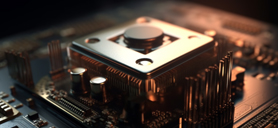FPGA vs. Microcontroller Technology: Similarities and Differences
5/8/2023 11:28:55 AM
Field-programmable gate arrays (FPGAs) and microcontrollers share similarities but are not identical. Both are compact computing units or integrated circuits within various devices and products. The primary distinction lies in their programmability. FPGAs can be programmed at the hardware level post-manufacturing, making them "field-programmable." At the same time, the microcontroller technology offers customization on a more limited scale. Moreover, FPGAs can process parallel inputs, whereas microcontrollers execute one code line at a time.
FPGAs provide increased personalization, with higher costs and more complex programming. On the other hand, microcontrollers are affordable yet offer limited customization. To understand the nuances between microcontrollers and FPGAs, delve deeper into their similarities and differences. Choosing between them is not a matter of superiority but requires consideration of various factors.
What is the Microcontroller Technology?
A microcontroller (MCU) is a compact computer designed for a specific purpose. It shares common components with other computers, such as a CPU, RAM, and input/output devices. However, unlike a desktop computer capable of executing numerous programs, a microcontroller is engineered to perform a single task repeatedly, autonomously, or upon user command.
Microcontrollers are embedded within various devices across consumer, manufacturing, medical, and other sectors. They are energy-efficient, consuming power in milliamps, making them cost-effective. Nevertheless, the price of the devices they are integrated into can differ significantly.
ü Microcontrollers are pervasive in daily life and found in many consumer items, including keyboards, monitors, printers, photocopiers, fax machines, telephones, TV remote controls, microwave ovens, washing machines and dryers, lawn sprinklers, and children's toys.
ü Apart from consumer products, microcontrollers also serve critical functions in traffic signals, automobile engine control systems, power tools, and implantable medical devices.
The list above only scratches the surface, as microcontrollers are incorporated into many modern devices. Each microcontroller fulfills a specific, recurring function. It may operate independently using a feedback control system (traffic signals) or respond to user input (flipping a switch or pressing a button) applicable to microwaves, washing machines, and TV remote controls.
What is the FPGA Technology?
A field-programmable gate or grid array (FPGA) technology is more complex than a microcontroller technology. Typically, chips arrive with pre-installed programming. Users can modify the software but not the hardware. However, this leads to the distinguishing characteristic of an FPGA – the ability for users to customize its hardware after purchase.
This feature is particularly valuable for engineers when creating prototypes for their application-specific ICs (integrated circuits). Another advantage of FPGAs is that they allow devices incorporating them to be modified without requiring completely new hardware.
Take, for instance, a scenario where regulations require vehicle rear-view cameras to function more quickly. Suppose FPGAs power these cameras. In that situation, manufacturers can implement the necessary adjustments without resorting to costly hardware replacements. Instead, they can reprogram the FPGA within each car's rear-view camera system. This enables modifications to be made to existing vehicles without rendering them obsolete.
Field-Programmable Gate Arrays comprise integrated hardware circuits featuring programmable logic blocks that are not pre-configured for a specific function during manufacturing. Users can customize and modify these devices through a hardware description language (HDL), connecting logic blocks such as AND as well as XOR with interconnects. Modern FPGAs contain numerous logic gates and RAM blocks, which allows for intricate computations. Some even include converters that can convert analog signals to digital or digital signals to analog, similar to FPAAs.
FPGA vs. Microcontroller: How They Match?
FPGA and microcontroller technologies are examples of flexible integrated circuits that allow manufacturers and end-users to specify their devices' particular functionality. Found in various devices such as traffic lights and laundry machines, these tiny, flat, square chips are embedded within these systems to perform specialized applications, making our lives easier.
Although visually similar with programmable pins surrounding them, FPGAs and microcontrollers are miniature computers programmed for distinct purposes, focusing on performing a single function rather than acting as personal or desktop computers. These circuits cater to tasks with varying levels of complexity, following preset commands to execute their designated functions.
Building Blocks
FPGA and microcontroller devices share fundamental similarities, as both are integrated circuits that use computer logic and binary to function. Integrated circuits, composed of semiconductor material like silicon, perform calculations and store data using digital or analog technology, with some FPGAs converting between the two. Digital technology is based on binary logic, while analog technology relies on a linear function of the input to calculate the output. Understanding the basics of computer logic is crucial when programming either a microcontroller or an FPGA.
Customization
FPGAs and microcontrollers offer post-production programmability, allowing manufacturers and end-users to tailor their functions for various applications across diverse industries. FPGAs stand out due to their extensive customization capabilities, making them ideal for complex, highly technical tasks. Simultaneously, microcontrollers are better suited for simpler applications.
FPGA vs. Microcontroller: How They Differ?
The primary distinction between the FPGA and microcontroller technology lies in the degree of personalization and intricacy. Furthermore, they differ in terms of affordability and user-friendliness. In essence, FPGAs offer enhanced adaptability, the capacity to handle more complicated tasks, and the ability to make changes to hardware after the fact. Remember that utilizing an FPGA requires a higher level of expertise and knowledge.
Although FPGAs possess certain benefits, microcontrollers are more affordable and simpler to operate. The majority of enthusiasts or novices would find the microcontroller technology to be a more suitable choice. In contrast, engineering firms and manufacturers might opt for FPGAs.
FPGA vs. Microcontroller: Power Consumption
FPGAs, known for their versatility and high-speed capabilities, often consume more power than microcontrollers, making them less suitable for power-efficient systems. This increased power consumption can be attributed to various factors, like low logic utilization due to place-and-route constraints, unused transistors, inefficient clock trees, and extended signal paths. Despite their use in emulation and prototyping, FPGAs are less power-efficient than components like ASICs.
In contrast, microcontrollers operate at much lower processing speeds, typically in the range of a few MHz, and consume significantly less power than FPGAs. They often feature idle or power-saving modes, enabling more sustainable operation. Some microcontrollers even have sleep currents below 1 µA and can function at just a few µA during slow clock rates. To improve power efficiency in FPGA systems, engineers usually incorporate microcontrollers on the board.
Ultimately, the choice between the FPGA and microcontroller technology should be based on the specific requirements of the project and the user's familiarity with the technology. Please don't hesitate to contact us if you have any more inquiries about FPGA vs. microcontroller technology.
Recommended News
-
Tel
0755-23616330 -
Whatsapp

 English
English
 English
English 简体中文
简体中文 Russia
Russia
 2022-10-29
2022-10-29


![A Guide to AVR Microcontroller [PDF] A Guide to AVR Microcontroller [PDF]](/upload/202306/03/202306031435158708.jpg)